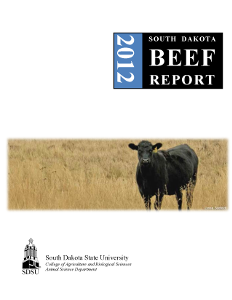Document Type
Report
Report Number
2012-1
Publication Date
2012
Summary
Several effective fixed-time AI (FTAI) protocols have been developed to facilitate AI while eliminating the need for estrus detection. Among these are the 5-d CO-Synch+CIDR (5d), PG 6-d CIDR (PG-CIDR), and 14-d CIDR-PG (CIDR-PG) protocols. While each of these protocols varies in duration and approach to synchronizing estrus and ovulation, each has been reported as an effective method to facilitate FTAI in beef heifers. Therefore, the objective of this study was to compare FTAI pregnancy rates in beef heifers synchronized with these three CIDR based protocols. Virgin beef heifers (n = 801) at four locations were synchronized with one of three protocols: 1) (5-day CO-Synch + CIDR) an injection of GnRH (100 μg; i.m.) and insertion of a CIDR on d -5, PG (25 mg; i.m.) and CIDR removal on d 0 with a second injection of PG (>4 h after CIDR removal) on d 0 and FTAI at 72 h after CIDR removal, 2) (PG 6-day CIDR) PG (25 mg; i.m.) on d -9, GnRH (100 μg; i.m.) and insertion of a CIDR on d -6, PG and CIDR removal on d 0, and FTAI at 66 h after CIDR removal, or 3) (14-day CIDR-PG) a 14-day CIDR insert from d -30 to -16, PG (25 mg; i.m.) on d 0, and FTAI at 66 h after PG. All heifers received an injection of GnRH (100 μg; i.m.) concurrent with FTAI. Timing of treatment initiation was offset to allow all heifers to receive FTAI concomitantly and at random. Pregnancy success was determined between 35 and 40 d after FTAI by transrectal ultrasonography. Blood samples were collected approximately 12 d before the beginning of each protocol and at the initiation of each protocol to determine estrous cycling status (77%). Data were analyzed using the GLIMMIX procedures of SAS. Fixed-time AI pregnancy success did not differ between treatments (P = 0.13; 62.5%, 56.9%, and 53.3%, for 5-day CO-Synch + CIDR, PG 6-day CIDR, and 14-day CIDR-PG; respectively) or location (P = 0.16; 51.5%, 62.7%, 56.1%, and 58.6% for location 1, 2, 3, and 4; respectively). However, heifers that had reached puberty by initiation of synchronization had greater (P < 0.01) pregnancy success compared to heifers that were prepubertal (60.7% and 47.3%; respectively). In summary, all three protocols had similar FTAI pregnancy success, and puberty status had the greatest impact on pregnancy success.
Number of Pages
5
Format
application/pdf
Language
en
Publisher
South Dakota State University
Rights
Copyright © 2012 South Dakota State University.
Recommended Citation
Perry, G.A.; Grant, J.K.; Walker, J.A.; Bridges, G.A.; Kruse, S.G.; Bird, S.; Heaton, K.; Arias, R.; and Lake, S.L., "Comparison of Three CIDR Based Fixed-time AI Protocols for Beef Heifers" (2012). South Dakota Beef Report, 2012. 1.
https://openprairie.sdstate.edu/sd_beefreport_2012/1


